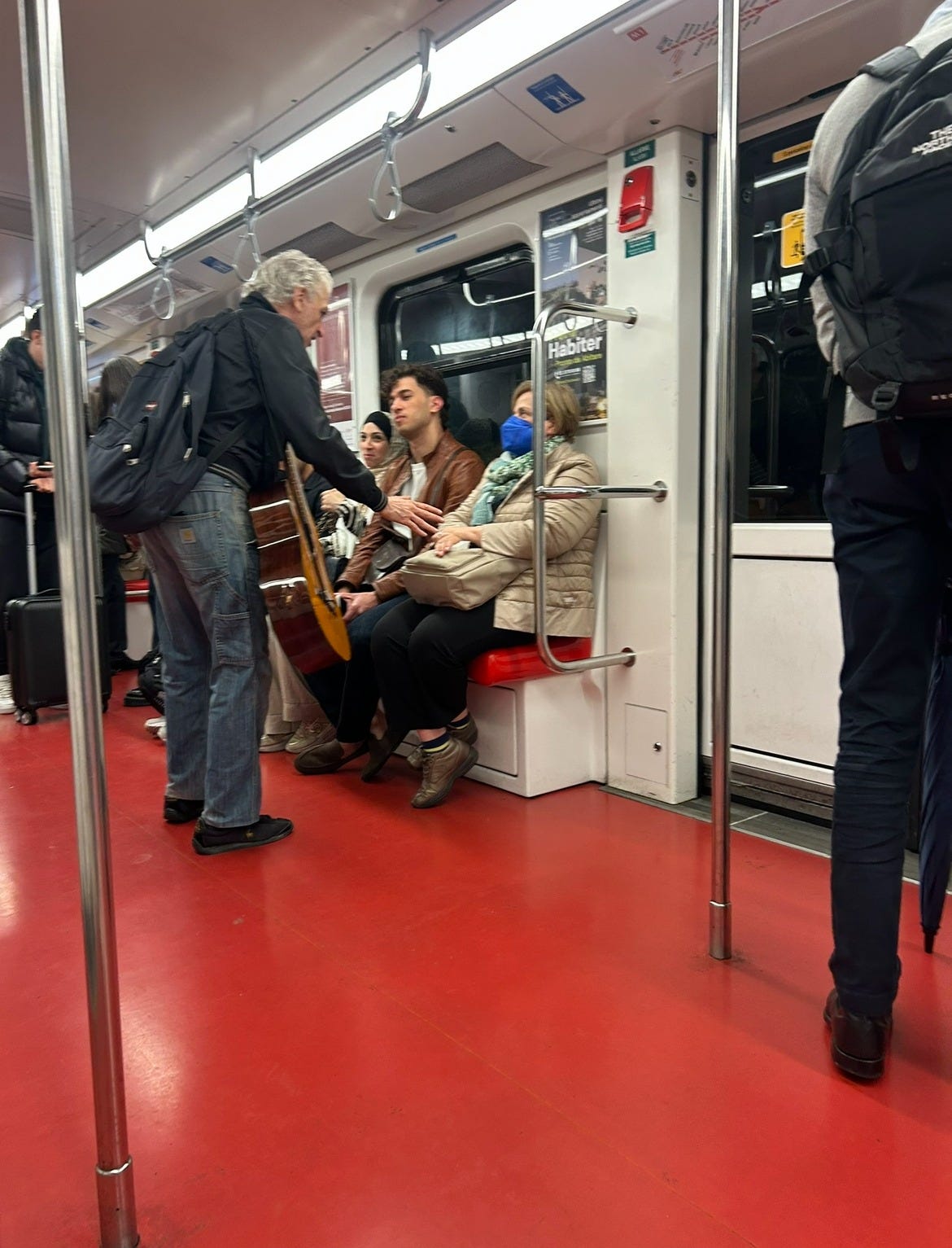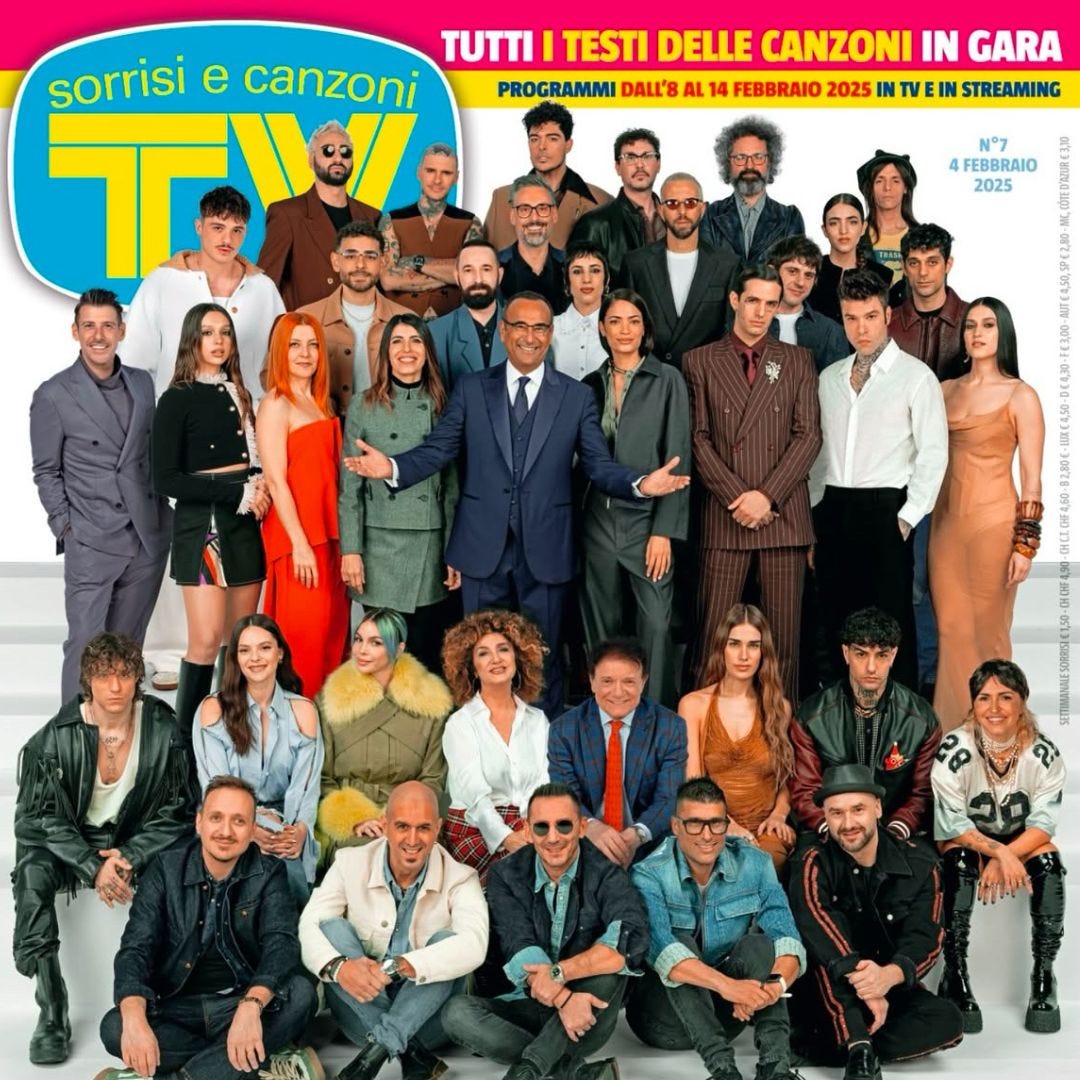La Dolce Beat: Music and Acclimation, Sanremo, and an Italian Panorama
a love letter/mixtape for my months in Milan
One under-discussed aspect of culture is the extent to which music is present in the local environment—how do people do most of their listening? If you go on a walk around the neighborhood, how soon is it until you hear someone blasting a tune? Is public transport a hushed affair or soundtracked by those who don’t believe in headphones? Do the grocery stores greet you with pop hits, muzak, or only the ambient hum of refrigerators?
Since blogging the Every Genre Project last year and taking a much-needed writing hiatus to simply observe and absorb, I’ve been in Italy for a few months now. I’m undergoing one of my last rites of passage (and a huge privilege) as a student—the whirlwind that is studying abroad, trying your best to absorb as much of a culture as possible in a few short months. Though many of my peers made their first brushes with Italian’s sneakily silent gs and tongue-straining rolled Rs, I had a bit of a head start. I began learning Italian in 2020, when Italy was all over the news cycle in those surreal early COVID days and I finally had the free time to learn a new language.
Music was an integral part of my learning during those early days, Italian indie playlists soundtracking my studies throughout 2020. My studies were stop-and-start over the years, so I rarely seek out much new Italian music and stuck to familiar gems. When I finally earned my student visa on a frazzled October day last year, I dove into Marco Castello’s Pezzi della Sera, a jazz-pop masterpiece inspired by a rich history of funk-inclined singer-songwriters and a precursor to the rich range of Italian music I’ve explored here. By pure coincidence, a few days ago I was in a record store in Siracusa—where I didn’t know Castello hailed from—and the owner told me he had just popped in the day before.
Over my time in Italy, I’ve fused my genre-spanning forays of last year with the goal of linguistic acquisition, diving into a new album by an Italian artist every day. This act has proved unintentionally pragmatic over my weeks here because you really don’t hear much Italian music naturally. The grocery stores leave your ears alone, and the stray café that plays music often throws on global pop hits. Milanese culture notoriously devotes attention to one’s public etiquette, so you seldom hear a car blowing out the speaker. The majority of people don’t walk around with headphones, and I barely ever hear humming. Music consumption is mostly individual and intimate, like the beauty tucked away in the lush courtyards within the most elegant Milanese estates. I witnessed subway serenaders only a handful of times.
However, one uniting event in February helped act as a peek through this opacity: Sanremo Music Festival. The Italian music competition in a glamorous Ligurian Riviera town began in 1951 and inspired Eurovision (and acts as Italy’s selection process each year). Though its roughly 30 contestants don’t represent specific regions, local pride certainly drives competitive fervor. It recalls the peak star-making days of American Idol, though it predates that show by several decades and contestants can be established artists or newcomers. It is the musical event every year in Italy, surrounded by drama, discourse, and celebration in equal measure.
Midway through the competition’s weeklong run, I stopped into a tabaccheria-coffee bar near my classes, the standard place in Milan to snag one’s two pick-me-ups at once (caffeine and nicotine). The bar served up glistening, succulent pistachio croissants, my personal magnet, alongside similarly gleaming cigarette boxes. As crumbs rained like volcanic ash onto my plate in the messy process of enjoying my brioche, a woman next to me spouted off similarly explosive Sanremo takes to a friend, peppered by the vulgar word “coglioni.” I heard preferences for Rome’s polarizing trapstar Tony Effe and sentimental balladeer Massimo Ranieri. She seemed to embrace a wide spectrum of modern Italian music, as I aspired to as well. You will find equal amounts of people who love and hate Italian trap in equal measure, though dislike seems to come from either a perception of abrasiveness and debauchery or simply turning up one’s nose at a popular and internationally influenced phenomenon.
In the end, this zebra-pattern jacket-clad lady’s picks did not prevail. Olly, a singer-songwriter from Genoa, won. This was in spite of critiques by many online for homophobic and misogynistic lyrics on past records. Whether or not due to the heat he’d gotten for these lyrics especially in the wake of national outrage against femicide in 2023, he declined the chance to bear Italy’s flag at Eurovision and passed it to glam-rocker runner-up Lucio Corsi. However, it seems the real winner in longevity was Giorgia’s (catchy as hell) ballad “LA CURA PER ME,” as I actually do hear it in public often, typically accompanied by some impassioned hum-alongs from those around me.
Sanremo has no true comparison in my native US: its relevance has prevailed through successive media eras, from its earliest shows being transmitted via the radio all the way through to the social media age, while American music-competition shows have dropped millions in viewerships since online platforms rendered that type of high-level talent-scouting a bygone artifact. It testifies to Italian music’s breadth and the room it has for genres and stars who came to fame across different eras, a national musical odyssey in a whirlwind five days.
After Sanremo concluded, I encountered much less public music discourse and was left without a good music-related opening line. But that moment in the café stayed in my thoughts. It was a salient microcosm of Milan’s lessons as a city. I noticed that the city is often dubbed ugly, even by other Italians*, but this unfair degradation negates its many lessons. It doesn’t constantly smack you upside the head with beauty, but with patience it taught me to appreciate subtlety and form, to be more exploratory, to maximize the joy of ephemeral connections and the knowledge gained from brief overheard conversations.
“Milano lontana dal cielo (Milan far from the sky)
Tra la vita e la morte continua il tuo mistero” (Between life and death your mystery continues)
– Lucio Dalla
* I’ll grant that Milan’s absurd rent prices are now the highest in Europe, so perhaps the insults are simply a way of expressing frustration which I can empathize with.
Coming back after five months, I don’t want to write your eyes off any more than I already have (if “talking your ears off” can be sensibly converted that way). So I share the music in question that has ornamented my life like decoration in movement, when the walls of my temporary abode weren’t my own to adorn with my mementos. Below is my sprawling Spotify playlist of nearly 300 of my favorite picks.
You’ll find many cantautori, the singer-songwriters who’ve also acted as proud representatives of their particular region’s spirit from Franco Battiato (Sicily), Riccardo Cocciante (Abruzzo), Lucio Battisti (Rome), Lucio Dalla (Bologna), Fabrizio de André (Genova), and Pino Daniele (Napoli). I also listened to acts like Anna Castiglia (Catania), Marco Castello (Siracusa), Joan Thiele (Milano), Colapesce and Dimartino (Solarino and Palermo) and Franco126 (Roma) who have carried the textual and conceptual torch in the past few years.
It also includes divas like Milan’s own Ornella Vanoni, Patty Provo, Rafaella Cara, and Mina, who became a go-to over the semester for her stunning voice, prolific and pioneering discography, and unparalleled bold visual direction. It’s also worth noting that Italian fame seems much kinder to its recipients, or perhaps for all the framing of Italy’s aging population as “problematic,” older people just live longer creatively embodied lives, with these icons continuing to record albums, compete in Sanremo, and sing duets with younger stars into their 80s.
Echoing last year’s genre-hopping, I voyaged to Italian takes on dub (Sanacore), neo-psychedelia (Post Nebbia), shoegaze (Felpa, chiaroscuro), country (Krano), pluggnb (Tony2Milli) and ambient (Cabaret du Ciel, legend Gigi Masin). Homegrown genres like italo-disco (“Disco Smack”), dream trance (Robert Miles), and the distinctive lushness and melody-work of composers working in the ‘60s like Piero Umiliani, Ennio Morricone, and Piero Piccioni also get their due spotlights. I tuned into Italy’s vibrant yet divisive trap scene—plus, rap’s high words-per-minute is optimal language practice—seen here in the likes of Ghali, Tony Boy, and Ele A. Pop oddballs like Pino D’Angio (the prince of late ‘70s Italian disco), Giuni Rosso (like Italy’s Yma Sumac), and Mango (atmospheric ‘80s) are harder to categorize, but are well worth a listen.
Crate-digging through vinyls whenever I came across them led me to some nicher finds, like Rondo Veneziano’s (much better than it sounds) classical crossover that evokes robots at a carnevale ball or Enzo Cervo, an unsung gem of Naples funk. Rondo Veneziano was but one act that enlightened me as to how pioneering Italy was and remains in producing pop that minces none of electronic music’s promise and dynamism (see: Matia Bazar), a legacy continued by recent acts here like Cosmo, Coca Puma and, Delicatoni. Across genre, the meticulous craftsmanship of these arrangements stands out; lush, dynamic, and enveloping, but not overwrought.
Boh. It’s just bye for now. I am thankful for all the people and all the songs that touched my life during this transformative experience. Milano, spero di poter tornare subito <3
Fine












Great to have you back, Reid HT. So much fun to hear about your Milan experience and listen to some Italian music, as well as see some photos.